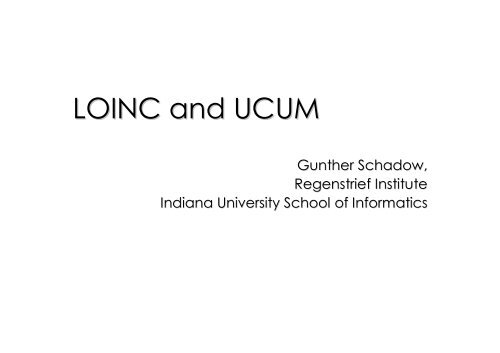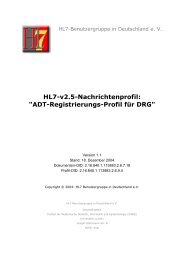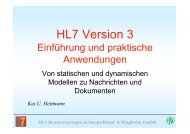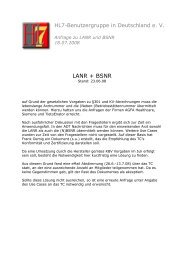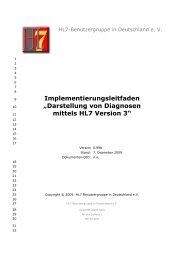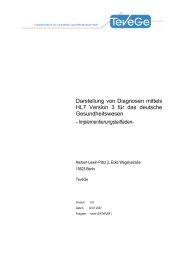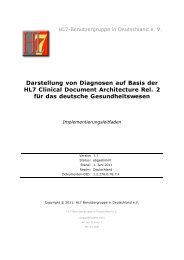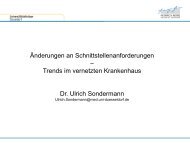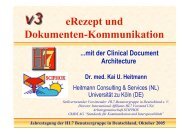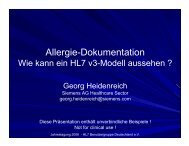LOINC and UCUM
LOINC and UCUM
LOINC and UCUM
Create successful ePaper yourself
Turn your PDF publications into a flip-book with our unique Google optimized e-Paper software.
<strong>LOINC</strong> <strong>and</strong> <strong>UCUM</strong>Gunther Schadow,Regenstrief InstituteIndiana University School of Informatics
Disclosures / Disclaimer• I am a recipient of <strong>LOINC</strong> as you are.• I am one of the early adopters of <strong>LOINC</strong> in 1996.• Extended <strong>LOINC</strong> for Blood Gas Analysis.• I support <strong>and</strong> Promote <strong>LOINC</strong>• I do not represent <strong>LOINC</strong>• I do not speak authoritatively• I may see things differently• I am also a member of the IUPAC C-NPUC• A competitor of <strong>LOINC</strong>• My views on the merits of either system are as anadopter.• I am, however, the author of <strong>UCUM</strong> <strong>and</strong> I believe in itsmerits <strong>and</strong> represent it.• I do not make money from <strong>UCUM</strong>, receive no financialsupport, <strong>and</strong> never had private contracts regarding<strong>UCUM</strong>.10/20/2008 Copyright (c) 1999-2008 Regenstrief Institute, Inc. 2
Warning• Terminology is NOT sufficient.• Even the best, most complete,terminology is just words (nomatter how systematic.)• Language is more than words:• Morphology (forms, lexemes)• Syntax (structure)• Semantics (meaning of structure)• Pragmatics (language as behavior)10/20/2008 Copyright (c) 1999-2008 Regenstrief Institute, Inc. 3
Anatomy of Observations1. Observation.code (Act.code):• The action you need to do in order tomake the observation.• E.g., Systolic blood pressure2. Observation.value:• The result obtained in the observationaction.• 120 mm[Hg]3. Time• Number x Unit4. Subject 5. Observer10/20/2008 Copyright (c) 1999-2008 Regenstrief Institute, Inc. 4
<strong>LOINC</strong>• Logical Observation Identifiers, Names<strong>and</strong> Codes, Regenstrief Institute.• Was: “Laboratory” OINC• Purpose:• Observation names• “name” as in “name = value pairs”• Not observation-valuesvalues• Systematic definitions• Pre-coordinated10/20/2008 Copyright (c) 1999-2008 Regenstrief Institute, Inc. 5
Major <strong>LOINC</strong> Parts• <strong>LOINC</strong> number• System (formerly “Specimen”)• Serum/plasma, whole patient, etc.• Component (formerly “Analyte”)• potassium, hemoglobin, body height• Property (Kind-ofof-Quantity)• Length, mass, substance concentration…• Scale type• Quantitative, ordinal, nominal• Time aspect• Point in time (PT) vs. certain intervals• Change, status, mapped-to.10/20/2008 Copyright (c) 1999-2008 Regenstrief Institute, Inc. 6
International St<strong>and</strong>ardPrinciples of Pre-coordination<strong>LOINC</strong>-CodeCode := Systemx Componentx Kind of PropertyC-NPU-Code:= Systemx Componentx Kind of Propertyx Unit of Measure“dedicated kind of property”10/20/2008 Copyright (c) 1999-2008 Regenstrief Institute, Inc. 7
<strong>LOINC</strong> Systems – Blood• Serum(SER) – 8421• Serum/Plasma(SER/PLAS) – 4654• Plasma(PLAS) – 280• Whole Blood(BLD) – 1984• Capillary Blood(BLDC) – 110• Arterial Blood(BLDA) – 64• Venous Blood(BLDV) – 37• Mixed-Venous Blood (BLDMV) – 22• White Blood Cell(WBC) – 256• E.g., CD-antigens,…• Red Blood Cell• E.g., blood type, fragility, …(RBC) – 31410/20/2008 Copyright (c) 1999-2008 Regenstrief Institute, Inc. 8
<strong>LOINC</strong> Systems (Other)• Physiology• Whole Patient(^PATIENT) – 2009 (Weight, Height)• (Whole) Fetus(^FETUS) – 230• Heart(HEART)– 493 (For EKG)• Other Fluids• Urine(UR) – 4540• Cerebrospinal Fluid (CSF) – 1250• Amnion Fluid(AMN) – 222• Gastric Fluid(GAST) – 206• Semen(SMN) – 201• Fluid, NOS(FLU) – 677• Miscellanea• Isolate(ISLT) – 1255• Tissue(TISS) – 676• Blood or Tissue(BLD/TISS) – 642• Unspecified(XXX)– 1804 (no, no)10/20/2008 Copyright (c) 1999-2008 Regenstrief Institute, Inc. 9
<strong>LOINC</strong> System - Summary• Above systems cover 70% of <strong>LOINC</strong>• Pick the System that fits best• Don’t t get hung up on Serum vs. Plasma• Physiologically relevant is plasma,• Serum vs. Plasma are Lab processing issues only.• Increasingly SER/PLAS is used.• Check scale type (QN, ORD, NOM)• Check time aspect (usually PT)• Check not outdated (not “mapped-to”)10/20/2008 Copyright (c) 1999-2008 Regenstrief Institute, Inc. 10
Scale Type• Quantitative (QN)• The result of the test is a numeric value that relates to a continuous numeric scale.Reported either as an integer, a ratio, a real number, or a range. The test resultvalue may optionally contain a relational operator from the set {=}. Validvalues for a quantitative test are of the form "7", "-7", "7.4", "-7.4", "7.8912", "0.125","
Kind of Property• Basic Kinds of Quantities• Length (LEN)– 1 m - 557• Elapsed Time (TIME)– 1 s - 498• Mass (MASS)– 1 kg - 452• Amount of Substance (SUB)– 1 mol - (few)• Plane Angle (ANGLE) – 180° - 176• Number (NUM) – 12 - 142• Common Physical Kinds of Quantities• Pressure (PRES) – 16 kPa, , 120 mm Hg - 315• Partial Pressure (PPRES)– 2 kPa, , 20 cm H 2 O - 116• Volume (VOL)– 1 L - 314• Area (AREA)– 1 m 2 - 58• Electrical Potential (ELPOT)– 1 V - 218• Velocity (VEL)– 1 m/s - 168• Areic Number (NARIC) – 1 /m 2 - 120• Lineic Number (INVLEN) – 1/m - 9410/20/2008 Copyright (c) 1999-2008 Regenstrief Institute, Inc. 12
Kind of Property• Nominal Properties <strong>and</strong> Oddballs• Finding (FIND) - 6830• Presence or Identity (PRID) - 2011• Susceptibility (SUSC) - 1280• Type (TYPE) - 585• Impression (IMP) - 465• Arbitrary (ARB) - 300• Instance Identifier (ID) - 241• Timestamp (TMSTP) - 233• Complex (CMPLX) - 18010/20/2008 Copyright (c) 1999-2008 Regenstrief Institute, Inc. 13
Kind of Property• Concentrations – Amount per Volume• Arbitrary Concentration (ACNC)– iU/mL- 12749• Mass Concentration (MCNC)– mg/dL- 5887• Substance Concentration (SCNC)– mmol/L- 2017• Number Concentration (NCNC)– /nL- 553• Catalytic Concentration (CCNC)– U/L - 417• Mass or Substance Concentration (MSCNC) – **** - 84• Titer (TITR) – 1:32 - 1910• Content – Amount per Mass• Fraction – Amount per same Kind of Amount (part overwhole)• Ratio – Amount per Amount from a different System• Rate – Amount per Time10/20/2008 Copyright (c) 1999-2008 Regenstrief Institute, Inc. 14
Kind of Property• Content – Amount per Mass• Mass Content (MCNT)- mg/g (HGB) - 303• Catalytic Content (CCNT)- U/g (HGB) - 119• Fraction – Amount per same Kind of Amount (part over whole)• Number Fraction (NFR) - % - 1084• Mass Fraction (MFR)- mg/g - 210• Catalytic Fraction (CFR)- U/U - 62• Volume Fraction (VFR)- %vol- 60• Ratio – Amount per Amount from a different System• Mass Concentration Ratios (MCRTO) - 519• Substance Concentration Ratio (SCRTO) - 337• Any ratio (RATIO) - 221• Velocity Ratio (VELRTO) - 66• Rate – Amount per Time• Mass Rate (MRAT)- g/s - 469• Volume Rate (VRAT)- mL/s - 270• Substance Rate (SRAT)- mol/s - 205• Number Rate (NRAT)- /min - 10510/20/2008 Copyright (c) 1999-2008 Regenstrief Institute, Inc. 15
How to find <strong>LOINC</strong>• Download it:• http://www.loinc.orgor• http://www.regenstrief.org• LOINDB.TXT (text file)• Simple to search (e.g., in emacs)• Simple to import in database• RELMA – <strong>LOINC</strong> mapping tool• Application which can be used for batchterm mapping.• Lots of detail in the Access database,including hierarchically organized parts.10/20/2008 Copyright (c) 1999-2008 Regenstrief Institute, Inc. 16
<strong>LOINC</strong> <strong>and</strong> RELMA tour …10/20/2008 Copyright (c) 1999-2008 Regenstrief Institute, Inc. 17
<strong>UCUM</strong> - Unified Code for Units ofMeasure• Scope• All units of measures being contemporarily used ininternational science, engineering, <strong>and</strong> business.• Purpose• To facilitate unambiguous semantically defined <strong>and</strong>computable communication of physical quantities withunits between computer systems.• Inspired by ISO 2955-1983, ANSI X3.50-1986, <strong>and</strong> HL7ISO+.• Predecessors (now obsolete) had many defects• “a” for “year” <strong>and</strong> “are”• “cd” for c<strong>and</strong>ela <strong>and</strong> centi-day• ounce: Avoirdupois? Troy? Apothecaries’?• many missing units, e.g., mm[Hg]• Specifies all units with computable semantics• Automatic conversion• No need for large tables10/20/2008 Copyright (c) 1999-2008 Regenstrief Institute, Inc. 18
<strong>UCUM</strong> is Easy <strong>and</strong> Precise• Human-friendly Codes with PreciseSemantics• Write units as you would when typing ascientific journal article draft in a plain-textemail• ug/dL, , not mcg/deciliters• g, kg, not gm, gms, kgs, , etc.• cm3 not cc• For st<strong>and</strong>ard units, you will be correctmost of the time.• Only beware of customary units, jargon,non-units, <strong>and</strong> arbitrary units.10/20/2008 Copyright (c) 1999-2008 Regenstrief Institute, Inc. 19
<strong>UCUM</strong> Definitions• Specification• Syntax Rules• Semantics Rules• Tables• Prefixes• Base Units• Derived Unit Atoms• Various h<strong>and</strong>y compilations of ready-made expressions for the confused.10/20/2008 Copyright (c) 1999-2008 Regenstrief Institute, Inc. 20
<strong>UCUM</strong> Syntax• Unit atom: g, m, min, [in_i[in_i],m[Hg]• Simple unit: prefix * atom• kg, mm, mm[Hg], not mmin, m[in_i]• Prefixes only for “metric” units• Unit terms• Exponents: m2, cm3• Multiplication: kg.m• Division: m/s• Combination: kg.m/s2• Numeric factors, Parentheses: mg/(12.h)• Annotations:• kg{potatoes},mg{creat}10/20/2008 Copyright (c) 1999-2008 Regenstrief Institute, Inc. 21
A Tour of <strong>UCUM</strong> Tables10/20/2008 Copyright (c) 1999-2008 Regenstrief Institute, Inc. 22
<strong>UCUM</strong> Semantics• Unit is a product of integer-powers of base units:• 1 N = 1 kg.m/s2 = 10 3 m 1 s - 2 g 1• 1 dyn/s/cm5 = 10 8 m - 4 s - 1 g 1• 1 mmol/L= 10 - 3 m -3 mol 1• 1 U/L = 1/60 10 - 3 m - 3 s -1 mol 1• Represented as:• Factor x vector of exponents• E.g., 1/60 10 -3 x [-3,[-1, 0, 1, 0, 0, 0]10/20/2008 Copyright (c) 1999-2008 Regenstrief Institute, Inc. 23
<strong>UCUM</strong> Semantics• 1 N = 1 kg.m/s2 = 10 3 m 1 s - 2 g 1• 10 3 x [1, -2, 1, 0, 0, 0, 0] 0• 1 dyn/s/cm5 = 10 8 m - 4 s - 1 g 1• 10 8 x [-4,-1, 1, 0, 0, 0, 0] 0• 1 mmol/L= 10 - 3 m -3 mol 1• 10 -3 x [-3,0, 0, 1, 0, 0, 0] 0• 1 U/L = 1/60 10 - 3 m - 3 s -1 mol 1• 1/60 10 -3 x [-3,-1,0, 1, 0, 0, 0] 010/20/2008 Copyright (c) 1999-2008 Regenstrief Institute, Inc. 24
Rules for What is a Unit• Sufficient criterion:• Anything measured where there are multiple unitswith constant conversions.• Not sufficient that you can define the idea, thereneeds to be some conversion.• Arbitrary units are a problem.• Bethesda Unit, GPL Unit, Todd Unit, even i.U.• Because they do not relate to anything else.• Count-nouns nouns are not units.• Whether “Erythrocytes”, “tablets”, “old shoes”,“heartbeats”,, or “hick-ups”,, these are just things(or events) <strong>and</strong> simple count numbers suffice• Most detail goes into the observation code(<strong>LOINC</strong>), not the Unit.10/20/2008 Copyright (c) 1999-2008 Regenstrief Institute, Inc. 25
<strong>UCUM</strong> Semantic ModelQuantity*1name: STRINGmetrologicDescription: TEXT1Kind of QuantityExpressedQuantityDedicated Kindof QuantityBase Kind ofQuantity11nDimensionedQuantitymagnitude: REALUnitname: STRINGsymbol: STRINGprintSymbol: TEXTBase UnitnSystem ofQuantities <strong>and</strong>Unitsname: STRING1DimensionBase Dimensionnsymbol: STRINGprintSymbol: TEXTname: STRINGsymbol: CHAR1nDimensionComponentexponent: INTEGER10/20/2008 Copyright (c) 1999-2008 Regenstrief Institute, Inc. 26
<strong>UCUM</strong> is Easy <strong>and</strong> Precise• Human-friendly Codes with PreciseSemantics• Write units as you would when typing ascientific journal article draft in a plain-textemail• ug/dL, , not mcg/deciliters• g, kg, not gm, gms, kgs, , etc.• cm3 not cc• For st<strong>and</strong>ard units, you will be correctmost of the time.• Only beware of customary units, jargon,non-units, <strong>and</strong> arbitrary units.10/20/2008 Copyright (c) 1999-2008 Regenstrief Institute, Inc. 27
Thank you• http://www.loinc.org• http://unitsofmeasure.org10/20/2008 Copyright (c) 1999-2008 Regenstrief Institute, Inc. 28


